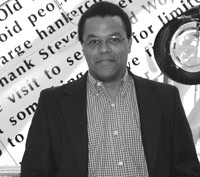| |
 |
| |
Larry
Benders '82 |
| |
|
Rock
around the clock
Larry
Benders '82 is helping preserve the history of modern music
by
Raksha Varma
Larry
Benders '82 landed the greatest gig of his life in 1999: an
opportunity to marry his passion for music with his business
savvy. As vice president of marketing and sales for the Rock
and Roll Hall of Fame Museum, Benders oversees several aspects
of the Cleveland landmark's market mix.
"I struck
a balance with this position," Benders says. "I'm able to
spend time with my family, while working in an environment
open to my appreciation for music and expertise in marketing
and sales."
Benders
and his team are also accountable for the Rock and Roll Hall
of Fame Museum's overall attendance. The 9-year-old nonprofit
cultural museum hosts about half a million visitors annually.
Designed by acclaimed architect I.M. PEI, the 150,000 square-foot
building is jammed with automobiles, original lyrics and vintage
clothing worn by the world's most celebrated and influential
rock icons.
"I've
had the opportunity to assemble the corporate mentality behind
music," says Benders, 47. "I am very lucky to be here. It
took a long time to get here, but it was worth it."
Originally
from Newton, Mass., Benders graduated in 1978 from Yale University,
where music was his full-time career. Not only did he sing
in and direct several groups, Benders was a member of the
Whiffenpoofs, the 95-year-old collegiate a cappella group.
After
working for Teradyne, a Boston-based supplier of automatic
test equipment and interconnection systems, Benders received
a leadership award from Johnson & Johnson Co., which honored
him with a full scholarship to the MBA program of his choice
and two summer internships with the company.
"I wanted
to study marketing because my father had a long career in
the field," says Benders, who entered the Kellogg School in
1980. "Kellogg taught me to ask questions, to ensure that
one's business resources are allocated against an objective."
Following
graduation, Benders went to work for Johnson & Johnson
in 1983.
"Johnson
& Johnson taught me the importance of product. Product
is all. Product must deliver," says Benders, who was an assistant
product manager at the New Jersey headquarters.
Benders,
who had married Alison Benders, a visiting student at Northwestern
Law School in 1982, eventually wanted a position that permitted
more time with his wife and four children and less time traveling.
After
working with a few companies, Benders became the chief marketing
officer of Ben and Jerry's Co. in 1997. He exercised three
important marketing strategies to make the brand more competitive.
"To succeed,
companies must know their customer," Benders says. "Understand
what compels a customer to buy your product. Distribution
is also key, so make sure people can find your product. Lastly,
companies must rely on accurate communication. Make sure that
what your product's message is supports what it does."
Benders
continued to rely on these strategies when he started working
for the Rock and Roll Hall of Fame Museum, a $15 million-dollar
operation. Not only is he responsible for the museum's earned
income and attendance, he is also responsible for brand awareness
and advertising efforts.
"Because
I work for a nonprofit, our advertising dollars are limited,"
he says. "Nonetheless, I try to market the museum as a regional
attraction with the use of several media," including radio
and outdoor advertising. Although TV and print are seldom
used, the museum's Web site (rockhall.com) is an important
advertising vehicle.
"Marketing
and advertising for a museum is similar to managing a conventional
brand, such as cereal," Benders says."To be successful, companies
have to figure out the attributes of their products and how
they relate to the target audience. "
Unlike
cereal, which can be distributed via stores in varying locations,
the Rock and Roll Hall of Fame Museum cannot change its distribution.
"Unlike other products, geography is a challenge for the museum,"
he says. "I try to make decisions that take that aspect into
account. Companies should use challenges to their advantage."
Although
managing a nonprofit museum can indeed be challenging, Benders
loves the thrill of "knowing his brand inside and out."
"I sell
rock and roll," Benders says. "Selling rock and roll isn't
curing cancer. But it's art and it's culture. Working to preserve
that is good work. It's not a lot of money, but it's good
work, and I'm proud."
|





